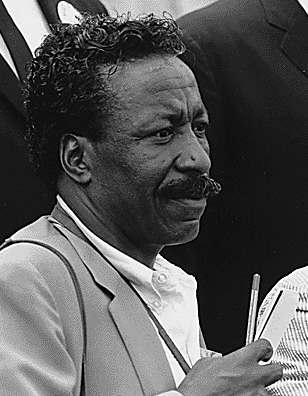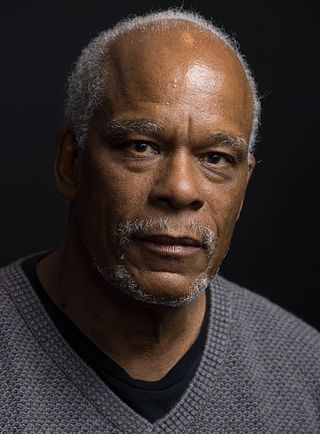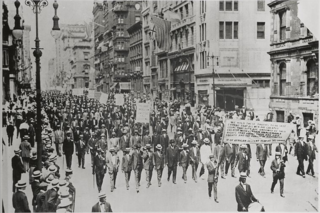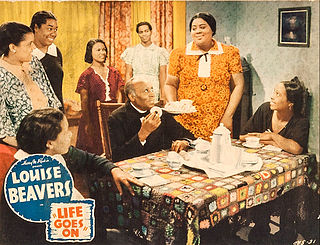Related Research Articles

Gordon Roger Alexander Buchanan Parks was an American photographer, composer, author, poet, and film director, who became prominent in U.S. documentary photojournalism in the 1940s through 1970s—particularly in issues of civil rights, poverty and African Americans—and in glamour photography. He is best remembered for his iconic photos of poor Americans during the 1940s, for his photographic essays for Life magazine, and as the director of the films Shaft, Shaft's Big Score and the semiautobiographical The Learning Tree.

Antoinette Frissell Bacon, known as Toni Frissell, was an American photographer, known for her fashion photography, World War II photographs, and portraits of famous Americans, Europeans, children, and women from all walks of life.

Stanley Earl Nelson Jr. is an American documentary filmmaker and a MacArthur Fellow known as a director, writer and producer of documentaries examining African-American history and experiences. He is a recipient of the 2013 National Humanities Medal from President Obama. He has won three Primetime Emmy Awards.

William D. Alexander was an American filmmaker. He made U.S. government sponsored newsreels for African American audiences. He later established his own production company, Alexander Productions, in New York City and became a film producer.

The Negro Silent Protest Parade, commonly known as the Silent Parade, was a silent march of about 10,000 African Americans along Fifth Avenue starting at 57th Street in New York City on July 28, 1917. The event was organized by the NAACP, church, and community leaders to protest violence directed towards African Americans, such as recent lynchings in Waco and Memphis. The parade was precipitated by the East St. Louis riots in May and July 1917 where at least 40 black people were killed by white mobs, in part touched off by a labor dispute where blacks were used for strike breaking.

Cinema of Ghana also known as the Ghana Film Industry nicknamed Ghallywood, began when early film making was first introduced to the British colony of Gold Coast in 1923. At the time only affluent people could see the films, especially the colonial master of Gold Coast. In the 1950s, film making in Ghana began to increase. Cinemas were the primary venue for watching films until home video became more popular. The movie industry has no official name as yet since consultations and engagements with stakeholders has been ongoing when a petition was sent to the Ministry of Tourism, Arts and Culture which suspended the use of the name Black Star Films.
Jennie Louise Touissant Welcome, born Jennie Louise Van Der Zee and also known as Madame E. Toussaint Welcome, was an African American visual artist who made influential photographs and films with her husband. She is associated with the Harlem Renaissance. Van Der Zee, who referred to herself as "the foremost female artist of the race," is recognized as being one of the only African American women filmmakers from the silent film industry.
Leon Dunkins Claxton was an American vaudeville performer turned producer who led the revue Harlem in Havana, which was staged for several decades and was a feature at the traveling Royal American Shows. An African American, his show featured black performers during the segregation era, and he came to be described as "one of the first African-Americans to find great success and infamy in the outdoor entertainment industry". Claxton also built a resort hotel for African Americans in Tampa, Florida.
Easy Street is a 1930 American film by Oscar Micheaux, an African American filmmaker. It features an African American cast. Known as the last silent achievement in his filmography, the film is considered lost. The plot reportedly revolved around a group of con artists trying to seize the savings of an old man.
The Spider's Web is a 1926 Oscar Micheaux film starring Evelyn Preer. It was remade in 1932 as The Girl from Chicago.
One Dark Night is an American film released in 1939. Also known as Night Club Girl. It was directed by Leo C. Popkin. It was produced by Harry M. Popkin. The film features an African American cast including Mantan Moreland in a dramatic role.

Million Dollar Productions was a movie studio in the United States active from 1937 until 1940. It was established to produce films with African American casts. It was a partnership between Harry M. Popkin, Leo C. Popkin and Ralph Cooper.
Bargain with Bullets is a 1937 American film. The first film produced by Million Dollar Productions, it features an African American cast of actors and performers. The gangster film is about the Harlem underworld. It was described as the first Hollywood "all-Negro" film. The film features several musical performances.
Zimbabwe has an active film culture that includes films made in Zimbabwe during its pre- and post-colonial periods. Economic crisis and political crisis have been features of the industry. A publication from the 1980s counted 14 cinemas in Zimbabwe's capital city, Harare. According to a 1998 report only 15 percent of the population had been to a cinema. European and American films have been made on location in Zimbabwe as well as Indian films. American films are popular in Zimbabwe but face restrictions limiting their distribution.
Straight to Heaven is an American film released in 1939. It was produced by Million Dollar Productions. It was advertised as having an all colored cast. Arthur A. Leonard directed. Sack Amusement Enterprises was the distributor.
Gang Smashers, also released as Gun Moll, is an American film released in 1938. It features an African American cast. The National Museum of African American History and Culture has a poster for the film in its collection. Leo C. Popkin directed the Million Dollar Productions film from a screenplay by Ralph Cooper. The University of South Carolina libraries have an 8-page pressbook for the film. Nina Mae McKinney stars in the film a thriller about the Harlem underworld and racketeering.
Reform School is an American film produced by Million Dollar Productions in 1939, starring Louise Beavers. The film was directed by Leo C. Popkin. In 1944 the film was re-released as Prison Bait.
William Lewis Nolte (1889–1965) was a screenwriter and film director in the United States. He directed the musical film The Duke Is Tops released by Million Dollar Productions. It was re-released in 1943 under the title The Bronze Venus. He is credited as a production manager for the 1942 film Thunder River Feud and as a line producer on the 1947 film Shadow Valley. From 1949 until at least 1957 he was an assistant director on several films.
Charles H. Turpin was a constable filmmaker, theater owner, and judge in St. Louis, Missouri. In 1910, he became the first African American elected to city-wide office in St. Louis. A legal dispute contested his estate.
Peter P. Jones was a photographer and filmmaker in the United States. He established the Peter P. Jones Film Company in Chicago in 1914 and filmed African American subjects including vaudeville acts and the 1915 National Half Century Exposition and Lincoln Jubilee. He also filmed community documentaries, chronicling contemporary African American life and social organizations.
References
- 1 2 3 Kahana, Jonathan (May 28, 2016). The Documentary Film Reader: History, Theory, Criticism. Oxford University Press. ISBN 978-0-19-973965-3 – via Google Books.
- 1 2 Klotman, Phyllis Rauch; Cutler, Janet K.; Press, Indiana University (May 28, 1999). Struggles for Representation: African American Documentary Film and Video. Indiana University Press. ISBN 0253213479 – via Google Books.
- ↑ Richards, Larry (September 17, 2015). African American Films Through 1959: A Comprehensive, Illustrated Filmography. McFarland. ISBN 9781476610528 – via Google Books.